Throughout the pandemic, enrollment in Medicaid has reached new levels, with more than 89 million adults and children covered because of a requirement for states to keep people continuously enrolled for the duration of the public health emergency. When the public health emergency ends, an estimated 15 million people will lose their Medicaid coverage. Individuals in states that have not expanded their Medicaid eligibility may suddenly find themselves in the coverage gap.
South Dakota
To date, six states have approved Medicaid expansion by ballot measure — Idaho, Maine, Missouri, Nebraska, Oklahoma, and Utah. After Missouri and Oklahoma’s successful ballot initiatives in 2020, South Dakota advocates put a constitutional amendment to expand Medicaid eligibility on the ballot for this November. While the measure appears to have broad support, proponents had to overcome a legislature-backed measure, Amendment C, which would have increased the threshold for passing ballot measures from a simple majority to 60 percent. Amendment C was defeated, but a number of other states have adopted or proposed amending their ballot initiative process to make it harder for voters to directly make policy changes.
If the South Dakota measure is approved, Florida and Wyoming will be the only remaining nonexpansion states with the option of expanding Medicaid by ballot initiative. Mississippi had a ballot initiative process, but a legislative fix is required before it can be used after a 2020 state Supreme Court ruling determined the ballot process is “unworkable and inoperative.”
Wyoming
Wyoming advanced a Medicaid expansion bill through its House in 2021, with the bill failing to get a vote on the Senate floor. There was optimism that Medicaid expansion could be added to the state budget during this year’s short legislative session, but those efforts were unsuccessful. A Medicaid expansion bill is expected to be introduced in the 2023 session.
North Carolina
North Carolina has been in the news recently over negotiations to expand eligibility; the state’s House and Senate passed expansion bills earlier this year. However, a key sticking point has been whether and how to modify the state’s certificate of need law, which regulates the expansion of health care facilities and services. Governor Roy Cooper and leaders in the state Senate have insisted certificate of need reforms should be coupled with Medicaid expansion. The North Carolina Healthcare Association, which supports Medicaid expansion and opposed certificate of need reforms, recently offered a proposal that could move negotiations forward.
If North Carolina reaches an agreement on expansion, approximately 600,000 people would gain coverage through expansion. This could spur other nonexpansion states to reconsider their stance. The success of Republican leadership in North Carolina to advance expansion bills in both chambers, combined with favorable views of Medicaid and the ARPA financial incentive, could make Medicaid expansion seem like a more politically viable option.
Conclusion
South Dakota, Wyoming, and North Carolina are the latest states to make major progress toward expansion, and if those efforts succeed, they could help build momentum in other holdout states. The expected coverage losses following the end of the public health emergency also could breathe new life into previously stalled efforts. Given these dynamics, expansion will continue to be an issue to watch in state legislative sessions in 2023 and beyond. In the meantime, 12 states continue to leave millions of their residents without affordable health care options.


